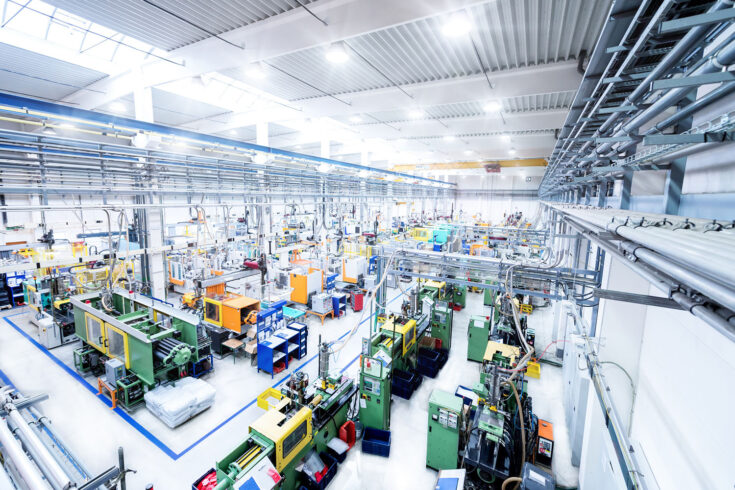The foundation industries are:
- metals
- ceramics
- chemicals
- paper
- cement
- glass.
They are a set of complex, interdependent systems that have evolved over decades.
They provide a net contribution of over £50 billion per year to the UK economy and are responsible for around 10% of national carbon dioxide (CO2) emissions.
We interact with foundation industry products on a daily basis. Elimination of these materials from the UK economy is not therefore a viable CO2 reduction strategy.
So we must work tirelessly to reduce the direct emissions associated with their production and the indirect emissions up and down the supply chain.
Implementation of circular economy
One approach to tackle CO2 emissions is the implementation of circular economy (CE) strategies.
The Ellen McArthur Foundation defines a circular economy as a system that “seeks to rebuild capital, whether this is financial, manufactured, human, social or natural. This ensures enhanced flows of goods and services. The system diagram illustrates the continuous flow of technical and biological materials through the ‘value circle’”.
In a recent report (PDF, 6MB), results showed that the implementation of CE strategies could reduce emissions by 40% in 2050. It showed CE strategies such as:
- waste elimination
- product reuse
- material recirculation across the cement, steel, plastic, and aluminium industries.
Industrial symbiosis
Industrial symbiosis is a specific CE tool, where the by-products of one process or whole industries are utilised as the raw materials or even an energy source for another.
Below, we discuss just some of the many industrial symbiosis methods practiced within the metals and cement industries and future opportunities in this area.
Finally, we touch on additional cross-sector processes that are under development to achieve net-zero.
Current practices
Industrial symbiosis has been utilised for many years between the steel and cement industries. Specifically where iron and steelmaking slags (which are produced in a range of different furnaces) are utilised as road aggregates; additions to cement and concrete, and as pH stabilisers.
Recent research led by the Materials Processing Institute and uniting the steel, glass, and cement industries, aimed to increase the value of basic oxygen steelmaking slag by adding waste glass.
This research has inspired spin-off projects between the collaborators addressing other by-product combinations thereby maintaining strong links between these foundation industries.
Bauxite residue
A major by-product of the aluminium industry is bauxite residue (also known as red mud). Around 160 million tonnes is produced annually, and it is estimated that three billion tonnes is currently stored and managed globally.
Approximately three million tonnes of bauxite residue is used annually as a raw meal component in Portland cement clinker. This forms the main cementitious material for concrete, and has also been considered for supplementary cementitious materials, which would further decrease:
- CO2
- energy requirements
- natural resource utilisation.
ISCF funded projects
The South Wales ‘with both eyes open’ project was funded by the Industrial Strategy Challenge Fund (ISCF) Transforming Foundation Industries: Fast Start Projects grant. This brought together multiple stakeholders within the foundation industry from the South Wales region.
The aim of the project was to analyse material and energy flows and identify potential opportunities for collaboration.
By clustering the foundation Industries former information silos were broken down to identify new opportunities for improved energy and resource efficiency through the co-location of industrial facilities.
LevWave project
The ‘LevWave’ project explored an innovative and highly efficient technology to produce a key sustainable chemical, levulinic acid (LA) by using aqueous streams available in the paper industry. The project was led by Drochaid Research Services Ltd.
LA is a ‘platform’ molecule to displace fossil resources in many applications including as a green solvent, a precursor for the production of advanced polymers, pharmaceuticals, additives and other commodity chemicals.
However, there is no current production in the UK. This project gathered data to inform the techno-economic and environmental assessments to determine the commercial viability of the process from the perspective of both the paper and chemical sectors.
Future opportunities
Despite all of the amazing work that currently takes place within the foundation industries, there remains a number of future opportunities to enhance the circularity of these systems.
Another example is that of zinc and iron-rich by-products from the iron and steelmaking industry. The blast furnace, basic oxygen furnace, and electric arc furnace all create zinc and iron-rich by-products that, due to the high zinc content, may not be recyclable back into the process.
Zinc accumulates in various process streams during both iron ore processing and scrap and waste recycling.
Once the concentration of zinc goes beyond a certain point, the material is no longer suitable for iron recovery. This is because a high zinc content leads to poor processing conditions in the blast furnace.
However, these by-products contain a significant concentration of iron and therefore, if the zinc can be removed, are perfect for recycling back into the process.
This presents an opportunity to develop new recovery techniques, improve the zinc recycling infrastructure in the UK, and unite the foundation industries to develop a cross-sector solution.
Towards net-zero
As the UK aims to achieve net-zero by 2050, the foundation industries are key players in the decarbonisation race.
Waste heat is a universal by-product across the foundation industries, providing a perfect opportunity for cross-sectoral engagement to reduce heating and energy costs.
Waste heat can be most effectively used as a heat source for other processes or process preheating and is often underexploited. Medium-grade heat that cannot be used for process heat can be used to raise steam or drive organic rankine cycle (ORC) machinery.
The steam that is generated can be used for other processes, to drive machinery, or convert to electric power. ORC machines are normally used to generate electricity.
Low-grade heat can be upgraded using heat pumps for process heat or distributed for use in space heating or community or district heating schemes.
Waste heat can be used both within the factory where it is generated and by neighbouring factories and communities.
Life cycle assessment
Industrial ecology, a relatively new field of study which focusses on material and energy flows through industrial systems, is supported by methodologies such as life cycle assessment (LCA).
LCA is an environmental accounting tool utilised to determine the environmental impacts of a product or service and has been in use since the 1960s.
An LCA can be used to identify environmental hotspots within a system, compare the environmental impacts of different aspects of a product or processes, benchmark, support policy, and develop mitigation strategies.
The European Commission has stated that the LCA methodology provides the best framework for the assessment of environmental impacts though consistent data and consensus LCA methodologies are required.
Accelerate change
Overall, while the foundation industries have made strides to establish a circular economy, there is still a way to go.
The funding opportunities provided by the Transforming Foundation Industries fund will support the foundation industries to reach net-zero by 2050 and increase material efficiency. This cross-industry approach will ensure knowledge sharing and accelerate change across the UK.
I would like to thank Michael Kenyon for his contributions to this blog.
If you would like to find out more about how circular economy strategies are applied within the foundation industries, you can join our sustainability webinar series and get in touch at tfi.flg@iuk.ukri.org
The Transforming Foundation Industries challenge is delivered by Innovate UK.
Top image: Credit: yoh4nn, E+, Getty Images




